Austrian Cultural Forum at 10
- 作者
- John Hill
- 发布于
- 4月 23, 2012
In 1992 Raimund Abraham won the competition for a new Austrian Cultural Instutite in Midtown Manhattan, beating 225 other competitors, all of Austrian descent. It took ten years to realize the 24-story building, renamed the Austrian Cultural Forum New York (ACFNY) when it opened its doors to the public on April 18, 2002. On the 10th anniversary of the building's completion—the 20th anniversary of the competition—World-Architects.com spoke with ACFNY Director Andreas Stadler to get his perspective on the building.
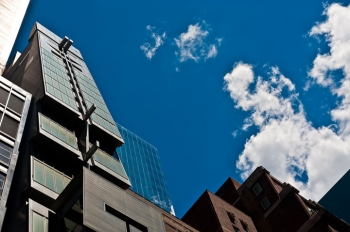
Austrian Cultural Forum, exterior. Photo: David Plakke, davidplakke.com (All photos are courtesy Austrian Cultural Forum New York.)
As the Director of ACFNY, what exactly do you do?
Well, the building itself has been designed to be the Austrian cultural embassy to the United States, and as a place of contemporary arts and intellectual exchange that is located in the world cultural capital New York. So it should also be seen beyond the United States, and this is actually what we are hopefully achieving. My role is to program all the artistic and intellectual events in a way that makes a difference for other, particularly New York-based institutions, but then also to other institutions in other parts of the world; it’s not just an American but also a global reach that we have.
I can give you an example: One of my first projects was to organize an exhibition [Under Pain of Death] on how artists reflect upon the death penalty. This was quite a success, not only here in New York—it was reviewed in the New York Times—but it was really noticed in many countries worldwide; in Italy, in Greece. I remember there was much buzz in the blogosphere, much attention given to this project, because it was a project that no other comparable institution would do, just for the simple reason that it combines politics and art. Which in a way is what people try to hide, but not to underline or to show. While many American institutions, such as museums for example, hide the political process that is behind the organization of an artistic program—the funders, the sponsors, the director, the curators, and so on—I tried to reveal it and say: This is a cultural embassy of Austria to the United States. Yes, we are a political institution, and therefore we tackle such issues of debate between Austria and the United States, between Europe and the United States, such as the death penalty. We invited people like Matthew Barney, Andreas Serrano, Mary Ellen Carrol, many American artists, but also of course Austrian artists, a Chinese artist, we made it a worldwide spectacle in a way, and it created discussion.
Well, the building itself has been designed to be the Austrian cultural embassy to the United States, and as a place of contemporary arts and intellectual exchange that is located in the world cultural capital New York. So it should also be seen beyond the United States, and this is actually what we are hopefully achieving. My role is to program all the artistic and intellectual events in a way that makes a difference for other, particularly New York-based institutions, but then also to other institutions in other parts of the world; it’s not just an American but also a global reach that we have.
I can give you an example: One of my first projects was to organize an exhibition [Under Pain of Death] on how artists reflect upon the death penalty. This was quite a success, not only here in New York—it was reviewed in the New York Times—but it was really noticed in many countries worldwide; in Italy, in Greece. I remember there was much buzz in the blogosphere, much attention given to this project, because it was a project that no other comparable institution would do, just for the simple reason that it combines politics and art. Which in a way is what people try to hide, but not to underline or to show. While many American institutions, such as museums for example, hide the political process that is behind the organization of an artistic program—the funders, the sponsors, the director, the curators, and so on—I tried to reveal it and say: This is a cultural embassy of Austria to the United States. Yes, we are a political institution, and therefore we tackle such issues of debate between Austria and the United States, between Europe and the United States, such as the death penalty. We invited people like Matthew Barney, Andreas Serrano, Mary Ellen Carrol, many American artists, but also of course Austrian artists, a Chinese artist, we made it a worldwide spectacle in a way, and it created discussion.
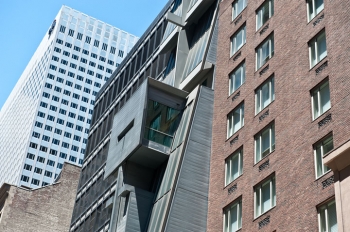
Austrian Cultural Forum, exterior. Photo: David Plakke, davidplakke.com
Does that exhibition, for example, have an expression in book form or the like that allows it to extend beyond the walls of the building?
We use every possible means of communicating our roles and our messages, whether it’s the media, whether it’s our exhibition catalogues; we have a lot of reviews. So it ‘s a very systematic way to introduce subjects and content that other institutions wouldn’t do, because of their political constructions.
And the same goes for music. We are quite successful with our music program, which is really concentrating on cutting-edge, contemporary music creation. We are expected to organize a lot of concerts with Mozart and Mahler, but we don’t do it, because you have it in all other concert halls in the city. So we would compete in an area where we wouldn’t have the money to be better than Carnegie Hall, Morgan Library, Lincoln Center—no chance. But since we decided to present a music program that is as edgy and contemporary as the architecture itself, we are visible.
Beforehand I was certainly wondering how the building relates to the programming, if there is something about the building—in terms of politics, of form, what have you—that leads you down these paths where you are tackling art and politics. It seems like the show downstairs [It's the Political Economy, Stupid] is along the same lines as the death penalty exhibition. Is that topic important in Austria now?
Absolutely. It got almost as much attention in Austria as it did here. But in Austria everything is noticed as soon as we do it here; We've had some terrific reviews in the U.S. media. I don't think many American institutions are in a position to mount an exhibition like this one —maybe some universities would do it—but it’s hard for the museums because they have to do exhibitions built around the interests of collectors, around the interests of funders. The political process is astonishingly hidden and difficult here; we on the other hand are able to cut through this, we have this liberty and we use it.
We use every possible means of communicating our roles and our messages, whether it’s the media, whether it’s our exhibition catalogues; we have a lot of reviews. So it ‘s a very systematic way to introduce subjects and content that other institutions wouldn’t do, because of their political constructions.
And the same goes for music. We are quite successful with our music program, which is really concentrating on cutting-edge, contemporary music creation. We are expected to organize a lot of concerts with Mozart and Mahler, but we don’t do it, because you have it in all other concert halls in the city. So we would compete in an area where we wouldn’t have the money to be better than Carnegie Hall, Morgan Library, Lincoln Center—no chance. But since we decided to present a music program that is as edgy and contemporary as the architecture itself, we are visible.
Beforehand I was certainly wondering how the building relates to the programming, if there is something about the building—in terms of politics, of form, what have you—that leads you down these paths where you are tackling art and politics. It seems like the show downstairs [It's the Political Economy, Stupid] is along the same lines as the death penalty exhibition. Is that topic important in Austria now?
Absolutely. It got almost as much attention in Austria as it did here. But in Austria everything is noticed as soon as we do it here; We've had some terrific reviews in the U.S. media. I don't think many American institutions are in a position to mount an exhibition like this one —maybe some universities would do it—but it’s hard for the museums because they have to do exhibitions built around the interests of collectors, around the interests of funders. The political process is astonishingly hidden and difficult here; we on the other hand are able to cut through this, we have this liberty and we use it.
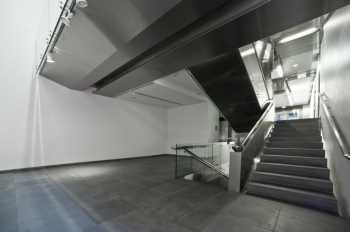
Austrian Cultural Forum, upper gallery. Photo: David Plakke, davidplakke.com
That brings to mind the Storefront for Art and Architecture, doing something around Occupy Wall Street recently, which was a short event.
Some not-for-profits link up, but not in such a systematic way. We have this exhibition on for three months with artists not only from the US, but from Spain, from Australia, from Austria, from Latin America, so it’s really a global perspective on the crisis of capitalism; we are very blunt about it.
I was only able to take a cursory glance at the exhibition, but I liked the piece highlighting Gerald Ford’s proclamation about not supporting New York in its crisis in the 1970s. It’s a piece that is contemporary but cognizant of history.
This exhibition is really interesting in the sense that the artwork was all done, with one exception, before Occupy Wall Street, so it was like two or three years ago. One of the works by Isa Rosenberger is a performance work, a video installation about a very famous German dance choreographer who did a dance in the 1930s about the same subject. It’s called the Dance of Death and it’s about the price of Capitalism. So through this exhibition you can see that it’s not only the “Drop Dead New York” saying by Gerald Ford, but you can go with the means of contemporary art back to the Great Depression.
That exhibition runs until April, the month when the building opened ten years ago. Is there something in the works to celebrate the anniversary?
Since we celebrate ten years of our existence in our new building, we have of course a program of celebrations, which consists of three parts. We organized an anniversary exhibition, in which we trace the ten most successful, imaginative and thought-provoking Austrian artists in the United States from the last ten years. So it’s a survey that tries to distill from all this material who from Austria made it to be interesting, and how and why. It should be a very exciting exhibition because it will present very unexpected results. It will open in May. On the very day of the anniversary, April 18th, we will present one of the world's foremost contemporary music ensembles, Klangforum Wien, who performed the inaugural concert exactly ten years ago. They will present a world premiere of a newly commissioned composition by Polish composer Agata Zubel. We will present all together ten world premieres of compositions written by the most acclaimed composers that we could find. So ten years, ten world premieres, ten visual artists. On top of it, we’ll produce a film about the architecture and the history and about all your questions.
Some not-for-profits link up, but not in such a systematic way. We have this exhibition on for three months with artists not only from the US, but from Spain, from Australia, from Austria, from Latin America, so it’s really a global perspective on the crisis of capitalism; we are very blunt about it.
I was only able to take a cursory glance at the exhibition, but I liked the piece highlighting Gerald Ford’s proclamation about not supporting New York in its crisis in the 1970s. It’s a piece that is contemporary but cognizant of history.
This exhibition is really interesting in the sense that the artwork was all done, with one exception, before Occupy Wall Street, so it was like two or three years ago. One of the works by Isa Rosenberger is a performance work, a video installation about a very famous German dance choreographer who did a dance in the 1930s about the same subject. It’s called the Dance of Death and it’s about the price of Capitalism. So through this exhibition you can see that it’s not only the “Drop Dead New York” saying by Gerald Ford, but you can go with the means of contemporary art back to the Great Depression.
That exhibition runs until April, the month when the building opened ten years ago. Is there something in the works to celebrate the anniversary?
Since we celebrate ten years of our existence in our new building, we have of course a program of celebrations, which consists of three parts. We organized an anniversary exhibition, in which we trace the ten most successful, imaginative and thought-provoking Austrian artists in the United States from the last ten years. So it’s a survey that tries to distill from all this material who from Austria made it to be interesting, and how and why. It should be a very exciting exhibition because it will present very unexpected results. It will open in May. On the very day of the anniversary, April 18th, we will present one of the world's foremost contemporary music ensembles, Klangforum Wien, who performed the inaugural concert exactly ten years ago. They will present a world premiere of a newly commissioned composition by Polish composer Agata Zubel. We will present all together ten world premieres of compositions written by the most acclaimed composers that we could find. So ten years, ten world premieres, ten visual artists. On top of it, we’ll produce a film about the architecture and the history and about all your questions.
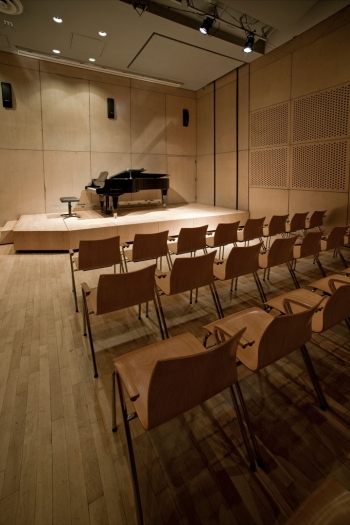
Austrian Cultural Forum, theater. Photo: David Plakke, davidplakke.com
So you’ve inherited the building from the previous Executive Director. Are there things about the building that you would like to change?
There are two things that are important to say. One, the fact that the building exists is a miracle in itself. And it really inherits a unique political situation in 1992, twenty years ago, the decisive moment when Austria was not yet part of the European Union, so still a neutral country. At the same time the Iron Curtain had fallen, and there was a boost of national identity, so the government decided to transform the old building into a new one commissioned by a world-famous architect, Raimund Abraham. This decision was taken in 1992, so actually we should celebrate not only ten years, but twenty years. Ever since, no other country from Europe has done such a construction, neither have we in Austria. This is the most spectacular construction of Austria both outside and inside the country.
Secondly, would I do something differently? That’s very hard to say. If we keep in mind the limitations of the situation, which is seven meters wide and twenty-something meters long, and a reclining facade due to air rights and the maximum of twenty stories, I think it’s hard to do anything differently here, with the exception of some small details.
There are two things that are important to say. One, the fact that the building exists is a miracle in itself. And it really inherits a unique political situation in 1992, twenty years ago, the decisive moment when Austria was not yet part of the European Union, so still a neutral country. At the same time the Iron Curtain had fallen, and there was a boost of national identity, so the government decided to transform the old building into a new one commissioned by a world-famous architect, Raimund Abraham. This decision was taken in 1992, so actually we should celebrate not only ten years, but twenty years. Ever since, no other country from Europe has done such a construction, neither have we in Austria. This is the most spectacular construction of Austria both outside and inside the country.
Secondly, would I do something differently? That’s very hard to say. If we keep in mind the limitations of the situation, which is seven meters wide and twenty-something meters long, and a reclining facade due to air rights and the maximum of twenty stories, I think it’s hard to do anything differently here, with the exception of some small details.
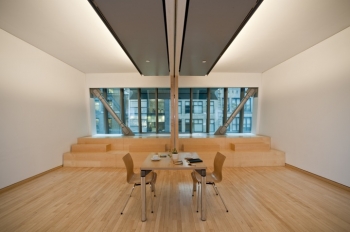
Austrian Cultural Forum, 6th floor. Photo: David Plakke, davidplakke.com
Given the constraints, do you feel like you’re growing out of the building? Or does growth not even come into play?
I happen to be not only the director of this institution, but I’m also the president of the group of European Cultural Institutes of New York [EUNIC]. All the European countries have some form of cultural representation in New York. These institutions, including the ACFNY, come from a time when culture was very much defined by national identity. Which is over. Due to the European Union and European integration, culture today is defined totally differently, what I call transversal. Transversal means it’s not even more disciplinarity—so culture is not just paintings, photography, music, dance—but all these disciplines overlap. So we have a transversality in there. Secondly it’s not anymore Italian, Austrian, American, but many national cultures integrate and overlap. So what is Austrian today? It doesn’t exist anymore.
There is a very famous artwork by Ben Vautier, one of the most famous Swiss-Italian artists. He did an art installation in 1992, the same year the ACFNY was conceived, at the World Expo in Seville, Spain. It created a huge scandal because he was invited by Switzerland to present the Swiss through visual arts, and the only thing he did was to write a big sign “La Suisse n’existe pas.” This is very emblematic of these other countries.
Coming back to your question: Are we outgrowing this institution? No we are not. On the contrary, the construction of our identity materialized in the building is more prominent than the artistic or cultural identity that we are representing. Also our budget is therefore declining rather than increasing, for two reasons. Number one, the national identity of Austria is more solidified today, so there is no need to show that we are who we are. Number two, the art sector and academic sector have become independent of the state. Last but not least, this is a good development. That is why we are not outgrowing it. We are happy if we are able to fill it. We are consistently happy with the place and the possibilities given by this architectural structure.
John Hill
I happen to be not only the director of this institution, but I’m also the president of the group of European Cultural Institutes of New York [EUNIC]. All the European countries have some form of cultural representation in New York. These institutions, including the ACFNY, come from a time when culture was very much defined by national identity. Which is over. Due to the European Union and European integration, culture today is defined totally differently, what I call transversal. Transversal means it’s not even more disciplinarity—so culture is not just paintings, photography, music, dance—but all these disciplines overlap. So we have a transversality in there. Secondly it’s not anymore Italian, Austrian, American, but many national cultures integrate and overlap. So what is Austrian today? It doesn’t exist anymore.
There is a very famous artwork by Ben Vautier, one of the most famous Swiss-Italian artists. He did an art installation in 1992, the same year the ACFNY was conceived, at the World Expo in Seville, Spain. It created a huge scandal because he was invited by Switzerland to present the Swiss through visual arts, and the only thing he did was to write a big sign “La Suisse n’existe pas.” This is very emblematic of these other countries.
Coming back to your question: Are we outgrowing this institution? No we are not. On the contrary, the construction of our identity materialized in the building is more prominent than the artistic or cultural identity that we are representing. Also our budget is therefore declining rather than increasing, for two reasons. Number one, the national identity of Austria is more solidified today, so there is no need to show that we are who we are. Number two, the art sector and academic sector have become independent of the state. Last but not least, this is a good development. That is why we are not outgrowing it. We are happy if we are able to fill it. We are consistently happy with the place and the possibilities given by this architectural structure.
John Hill
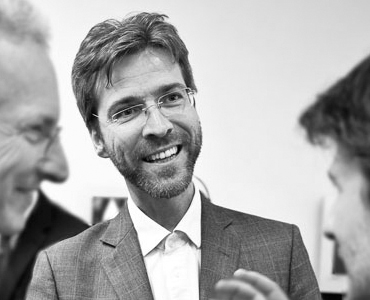
Andreas Stadler
Since fall 2007 Andreas Stadler has served as Director of Austrian Cultural Forum New York, Consul; 2004-2007 as advisor for Science, Arts and Culture to the President of the Republic of Austria; 1999-2004 as director of the Austrian Cultural Forum in Warsaw, Poland; 1995 – 1999 as Deputy Ambassador in Zagreb, Croatia. Mr. Stadler studied political science at the Universities of Vienna, Warsaw and at the European University Institute in Florence. Besides his official functions he occasionally publishes on issues related to European Politics, cultural policies and politics of Arts in various Austrian and Polish newspapers and magazines.
Since fall 2007 Andreas Stadler has served as Director of Austrian Cultural Forum New York, Consul; 2004-2007 as advisor for Science, Arts and Culture to the President of the Republic of Austria; 1999-2004 as director of the Austrian Cultural Forum in Warsaw, Poland; 1995 – 1999 as Deputy Ambassador in Zagreb, Croatia. Mr. Stadler studied political science at the Universities of Vienna, Warsaw and at the European University Institute in Florence. Besides his official functions he occasionally publishes on issues related to European Politics, cultural policies and politics of Arts in various Austrian and Polish newspapers and magazines.
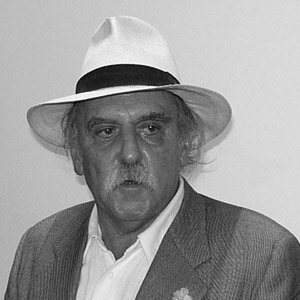
Raimund Abraham (1933-2010) was an Austrian architect who moved to the United States in 1964, teaching for most of his career at Cooper Union in New York City. At the time of his death he was teaching at SCI-Arc in Los Angeles. Since Mr. Stadler took helm of the ACFNY five years after its completion, W-A also spoke with building manager Manred Kapper, who started working at the ACFNY in 2000. He gave us some personal insight into working with Abraham when the building was under construction.
Were you working directly with Raimund Abraham?
I got to know him a little bit. He was a cool guy, I liked him. The first time I met Abraham was a weird situation because the Director [Christoph Thun-Hohenstein] put me in charge of giving tours through the building, I had to show people around. There were a lot of political issues in Austria at the time surrounding the cost of the building. So there were people coming from some newspapers, and they didn't say from the beginning that they were from the press, just that they wanted to see the building. But you could tell from the moment they asked a question, who they were. It caused a lot of headaches for me, because I didn't want to lie, I didn't want to say anything untrue. On the other hand, I needed to be loyal and keep certain information classified. So when I met Abraham, the first thing I said was, "Mr. Abraham, you're giving me a lot of headaches." And he looked at me like, "What do you mean?" I explained it and he replied, "Well, don't lie. Then you won't get any headaches."
Did Abraham have a presence after the building opened?
I think this building was very close to his heart in a way. It made him very famous in Austria. In his profession he had his status, but in the greater public nobody knew who Raimund Abraham was. So the building gave him a different status in Austria. He always had an eye on the buidling, even if he wasn't here. He was always present. If you wanted to change some little thing, you would run it past him, and you could count on his input. So he was here, he was present.
Were you working directly with Raimund Abraham?
I got to know him a little bit. He was a cool guy, I liked him. The first time I met Abraham was a weird situation because the Director [Christoph Thun-Hohenstein] put me in charge of giving tours through the building, I had to show people around. There were a lot of political issues in Austria at the time surrounding the cost of the building. So there were people coming from some newspapers, and they didn't say from the beginning that they were from the press, just that they wanted to see the building. But you could tell from the moment they asked a question, who they were. It caused a lot of headaches for me, because I didn't want to lie, I didn't want to say anything untrue. On the other hand, I needed to be loyal and keep certain information classified. So when I met Abraham, the first thing I said was, "Mr. Abraham, you're giving me a lot of headaches." And he looked at me like, "What do you mean?" I explained it and he replied, "Well, don't lie. Then you won't get any headaches."
Did Abraham have a presence after the building opened?
I think this building was very close to his heart in a way. It made him very famous in Austria. In his profession he had his status, but in the greater public nobody knew who Raimund Abraham was. So the building gave him a different status in Austria. He always had an eye on the buidling, even if he wasn't here. He was always present. If you wanted to change some little thing, you would run it past him, and you could count on his input. So he was here, he was present.